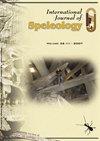Vodeni Rat(克罗地亚赫瓦尔省Sveti Klement岛)具有考古遗产的洞穴中的蛤壳类动物
IF 1.3
4区 地球科学
Q3 GEOSCIENCES, MULTIDISCIPLINARY
引用次数: 1
摘要
在克罗地亚Sveti Klement岛Vodeni Rat的anchialine洞穴中发现的一组四个双耳罐,位于水深24米的岩石突出处,表明从罗马共和时期晚期到中世纪早期,岛民和/或路过的水手在这个水坑底部开采了淡水资源。换句话说,在公元4世纪至7世纪之前,Vodeni Rat并不是一个洞穴,而是一个更新世的岩溶坑,底部有一个淡水池。根据在坑中发现的最年轻的完整双耳罐的考古年龄,公元4 - 7世纪之后,海水开始通过周围石灰岩中新打开的裂缝渗入这个洞穴。目前,29 m深水体呈层状,底层为咸水层,表层为淡水层,中间为过渡性微咸水层。通过对岩洞水柱物理生物学特征的研究,揭示了岩洞水柱中介形类、桡足类、片足类和温生纲等甲壳类动物的多样性和高度分区性。一些已知只在高盐生境中特有的物种是从底层盐层中收集的,而其他已知的淡水来源的物种则是在上层水层中发现的。这表明,在中世纪早期导致海水渗入这个岩溶坑的事件发生之前,淡水居民就已经在这个洞穴里了。本文章由计算机程序翻译,如有差异,请以英文原文为准。
Stygobitic crustaceans in an anchialine cave with an archeological heritage at Vodeni Rat (Island of Sveti Klement, Hvar, Croatia)
A group of four amphoras found in the anchialine cave of Vodeni Rat in the Croatian island of Sveti Klement, on a rocky ledge at 24 m water depth, indicates that a freshwater source was exploited at the bottom of this karstic pit by islanders and/or passing-by sailors from the late Roman Republican Period to the Early Medieval Period. In other words, prior to the 4th–7th century CE, Vodeni Rat was not an anchialine cave but a Pleistocene karstic pit with a freshwater pool at the bottom. Seawater started to infiltrate this cavity via newly opened fissures in the surrounding limestone after the 4th–7th century CE, as the archeometric age of the youngest intact amphora found down in the pit suggests. At present, the 29-m-deep water body is stratified, with a saline water layer at the bottom, a freshwater layer at the surface, and a transitional brackish water layer in the middle. Our study of the physical and biological characteristics of the cave water column revealed diversified and highly partitioned populations of stygobitic crustaceans including ostracods, copepods, amphipods, and thermosbaenaceans. Some species known to be exclusively endemic of highly saline habitats were collected from the bottom saline layer, whereas others known to be of freshwater origin were found in the upper water layer. This suggests that the freshwater dwellers were already present in this cave prior to the early medieval event that caused seepage of seawater into this karstic pit.
求助全文
通过发布文献求助,成功后即可免费获取论文全文。
去求助
来源期刊

International Journal of Speleology
地学-地球科学综合
CiteScore
3.10
自引率
23.10%
发文量
12
审稿时长
>12 weeks
期刊介绍:
The International Journal of Speleology has the aim to get cave and karst science known to an increasing number of scientists and scholars. The journal therefore offers the opportunity to all scientists working in and on karst to publish their original research articles or their review papers in an open access, high quality peer reviewed scientific journal at no cost. The journal offers the authors online first, open access, a free PDF of their article, and a wide range of abstracting and indexing services.
 求助内容:
求助内容: 应助结果提醒方式:
应助结果提醒方式:


